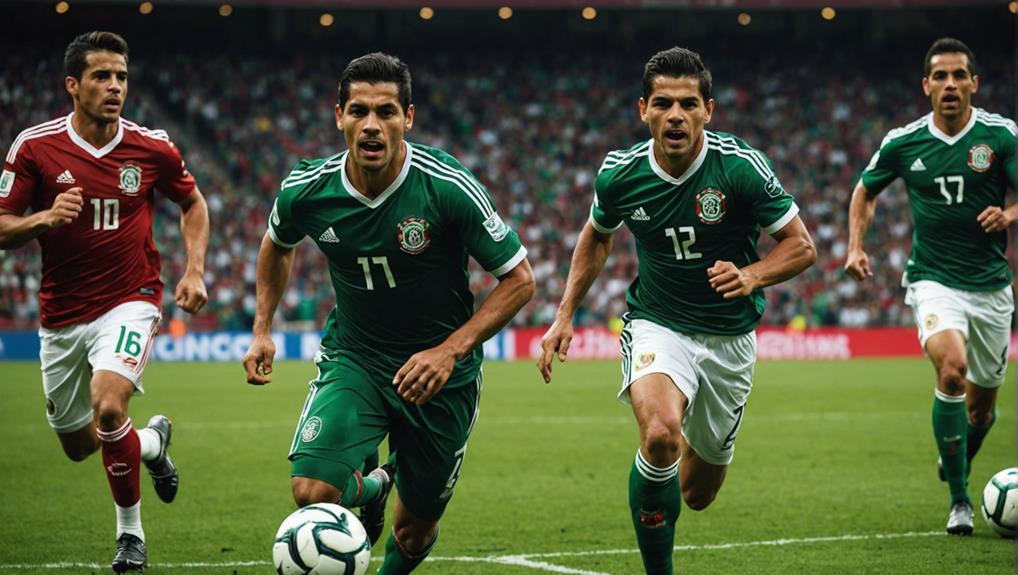
Exploring the Mexico National Soccer Team: Achievements and Key Players
July 27, 2024Discover the Mexico National Soccer Team's rich history marked by notable achievements in international tournaments and legendary players like Hugo Sánchez, Javier 'Chicharito' Hernández, and Rafael Márquez, who have made indelible marks on the sport. From impressive World Cup runs to victories in the CONCACAF Championship and Gold Cup, Mexico's legacy in soccer shines brightly. Uncover the team's coaching changes, stadium traditions at the iconic Estadio Azteca, controversies, and fierce rivalries like the longstanding one with Argentina. Mexico's golden era in the 1950s and 1960s and its modern competitive spirit await your exploration.
Historical Overview
The Mexico National Soccer Team's historical journey began in 1923 with their inaugural official match against Guatemala. This milestone marked the start of Mexico's presence in international football.
As they continued to compete, Mexico made significant strides, participating in the 1930 FIFA World Cup, where they showcased their talent on a global platform. One standout figure in Mexico's soccer history is Antonio Carbajal, who made history by being the first player to play in five consecutive World Cups, solidifying Mexico's reputation in the sport.
Throughout the years, Mexico continued to make an impact, with notable achievements like winning the 1965 CONCACAF Championship. These victories not only highlighted Mexico's prowess within the region but also set the stage for future successes on the international stage.
With a rich history filled with memorable moments and talented players, Mexico's national soccer team has left a lasting legacy in the world of football.
Achievements in International Competitions
Exploring Mexico National Soccer Team's track record in international competitions reveals a history rich with notable achievements and standout performances. Mexico's success spans various tournaments, including the FIFA World Cup and the CONCACAF Gold Cup.
The team made impressive runs to the quarterfinals of the 1970 and 1986 World Cups, demonstrating their strength on the global stage. Additionally, Mexico's victory in the 1965 CONCACAF Championship marked their first major international success, paving the way for future triumphs.
In recent years, Mexico has continued to excel in regional competitions, such as securing a spot in the 2023 Gold Cup final. The team's dominance in the CONCACAF region was further highlighted by claiming the CONCACAF spot at the prestigious Confederations Cup in 2015.
Furthermore, Mexico's win in the inaugural CONCACAF Cup in the same year solidified their position as a powerhouse in regional soccer. These achievements showcase Mexico's prowess in international competitions and the key players who've contributed to their success.
Coaching Changes and Team Management
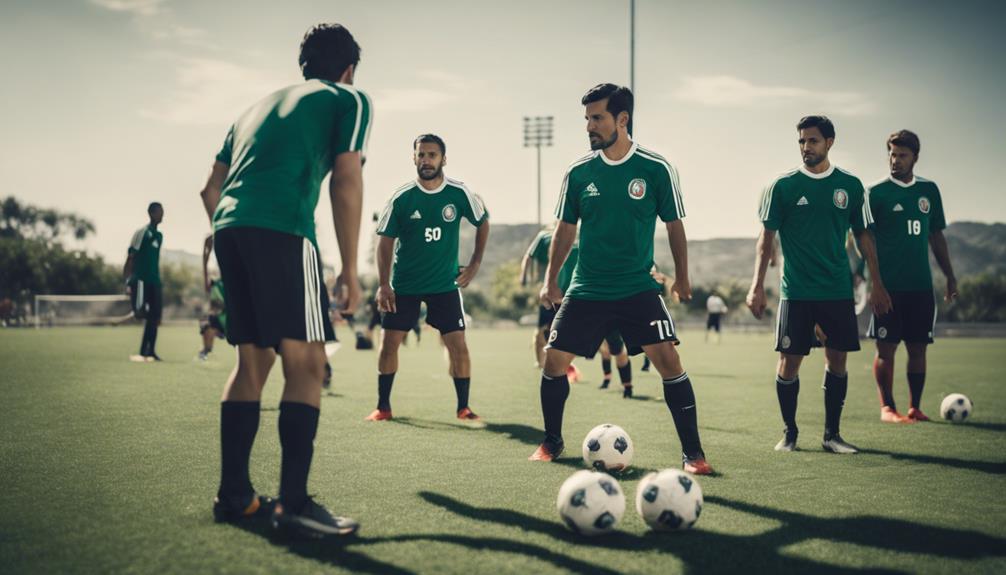
Delving into the recent shifts in coaching and team management within the Mexico national soccer team reveals a series of notable changes and developments. Gerardo Martino took the reins as head coach in 2019, succeeding Juan Carlos Osorio. However, subsequent coaching changes saw Diego Cocca assume control in 2023, followed by Jaime Lozano's appointment.
Unfortunately, Lozano's tenure was short-lived as he was dismissed in 2024 due to Mexico's premature exit from the Copa America. Following a subpar performance in the Nations League, Mexico parted ways with Cocca.
As the national team searches for a new coach, the focus shifts to preparing for the 2026 World Cup, which will be held on home soil. The upcoming coach will face the challenging task of steering Mexico through the obstacles of international competition and ensuring the team is ready to compete at the highest level.
The team management will play a pivotal role in shaping the future of the Mexico national team.
Stadium and Kit Details
Estadio Azteca stands tall, hosting Mexico's national team with pride. The tricolor kit system, a symbol of national identity, has evolved through the years.
Witness history unfold at the iconic venue, where unforgettable World Cup Final moments were etched in Mexican football lore.
Estadio Azteca Iconic Features
With a seating capacity of 87,523 spectators, the iconic Estadio Azteca serves as the official home stadium for the Mexico national team. Known for its rich history and significance in football, Estadio Azteca has been a witness to numerous memorable matches, including hosting the FIFA World Cup Final in 1970 and 1986. The stadium's grandeur and electric atmosphere make it a symbol of Mexican football passion.
Estadio Azteca's distinctive features include its sheer size, vibrant crowd, and the legendary 'Azteca Leap' performed by fans. This leap, where spectators jump in unison, creates a spectacle that adds to the stadium's unique charm. The sheer magnitude of 87,523 fans roaring in support of the national team is a sight to behold and an experience that every Mexican football fan cherishes.
As the heart of Mexican football, Estadio Azteca stands as a monument to the country's soccer heritage, embodying the spirit and pride of the Mexico national team.
Mexico's Kit Evolution
When exploring the evolution of Mexico's kits, one can observe a traditional tricolor system featuring green, white, and red colors. Adidas made a significant mark in 2010 with Mexico's World Cup kit, showcasing vibrant colors and intricate designs.
In a surprising move in 2015, Adidas introduced an all-black color scheme for Mexico's home kit, deviating from the classic tricolor system. This change sparked mixed reactions among fans but added a modern twist to Mexico's traditional look.
Estadio Azteca, with its 87,523 seating capacity, serves as the official home stadium for the Mexico national team. The stadium's rich history includes hosting the FIFA World Cup Final in 1970 and 1986, solidifying its iconic status in Mexican football lore.
Whether clad in the vibrant tricolor system or the bold all-black kit, the Mexican national team continues to honor its heritage while embracing innovation in its kit designs at the historic Estadio Azteca.
World Cup Final Moments
In the historic World Cup Final moments at Estadio Azteca, Mexico's vibrant tricolor kits have often symbolized the nation's footballing spirit. The iconic stadium, Mexico's home ground, witnessed the FIFA World Cup Final in 1970 and 1986, captivating fans with its official capacity of 87,523 spectators.
Mexico's traditional use of the tricolor system in their kits pays homage to the Mexican flag's colors, reflecting the country's pride and heritage on the global stage. Adidas played a pivotal role in shaping Mexico's World Cup kit legacy, introducing innovative design elements in the 2010 edition that caught the eye of fans worldwide.
In a surprising departure from tradition, the 2015 Mexico home kit stunned supporters with an all-black color scheme, showcasing a modern twist on the classic tricolor design. As Mexico continues to leave its mark on the World Cup stage, the combination of Estadio Azteca's grandeur and the evolution of Mexico's kits ensures that every final moment is etched in footballing history.
Controversies and Rivalries
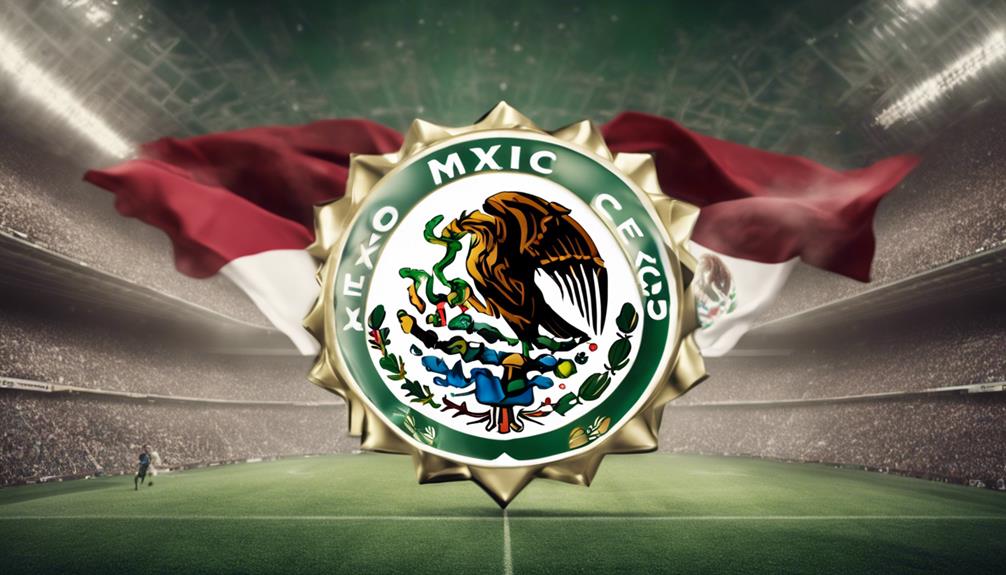
Amidst the Mexico National Soccer Team's journey, controversies and rivalries have played significant roles in shaping their competitive landscape.
The team has faced issues with the use of a homophobic chant during games, leading to disciplinary actions from FIFA.
In the Copa America 2016, Mexico's campaign ended in defeat, highlighting their struggles in international tournaments.
Mexico has a longstanding rivalry with Argentina, marked by intense on-field clashes and fan conflicts.
On the other hand, they've shown dominance against Costa Rica, boasting 32 wins, 20 draws, and 6 losses in their matchups.
Despite leading Group F in the 2018 World Cup, Mexico failed to advance past the Round of 16, showcasing their inconsistency in major competitions.
These controversies and rivalries haven't only stirred emotions among fans but have also influenced the team's performance and reputation on the global stage.
Early Years and Birth of *El Tri
The Mexico National Soccer Team, amidst its controversies and rivalries, traces its roots back to the early years of the sport, marking the birth of *El Tri in 1929. In the 1920s, the team faced challenges and inconsistencies as they sought to find their place in the international soccer scene. However, key events shaped their journey towards becoming a formidable force:
- First Official Match: The Mexico national team played their inaugural official match in 1923 against Guatemala, laying the foundation for a long and storied history.
- 1930 FIFA World Cup: Mexico made their debut in a major international tournament at the 1930 FIFA World Cup. Although their performance was modest, it was a significant step in their development as a competitive team.
- Establishing as a Force: By the 1930s, Mexico started establishing themselves as a competitive team, setting the stage for future successes and the birth of their iconic nickname, *El Tri*.
The Golden Era
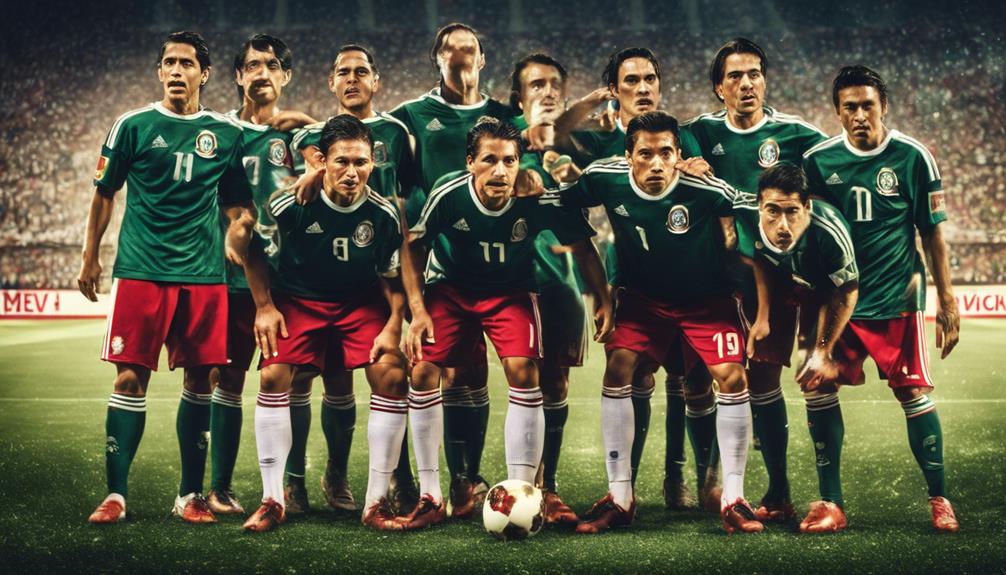
Mexico's Golden Era in soccer history shone brightly during the 1950s and 1960s. The team's impressive run in the 1954 FIFA World Cup marked a significant milestone, reaching the quarter-finals and capturing the world's attention. Antonio Carbajal, the legendary goalkeeper, became a standout player during this period, setting a record for the most World Cup appearances that still stands today.
In 1966, Mexico continued to showcase its prowess on the international stage by participating in the FIFA World Cup held in England. This tournament further solidified Mexico's reputation as a formidable team in the global football community. The Golden Era also witnessed the rise of iconic players like Hugo Sánchez, whose influence on Mexican soccer was profound and long-lasting.
With key players like Sánchez and Carbajal leading the charge, Mexico's Golden Era laid the foundation for future successes and cemented the team's legacy in world football.
The Rise of *El Tri
You're about to uncover how Mexico's national soccer team, *El Tri*, ascended to new heights through strategic coaching changes and a commitment to excellence.
By analyzing their growth trajectory and the challenges they faced head-on, you'll gain a deeper understanding of how Mexico positioned itself as a formidable force in the world of soccer.
Stay tuned to explore the rise of *El Tri* and the compelling narrative that shaped their journey to success.
Coaching Transition Overview
Amidst Jaime Lozano's departure, the Mexico National Soccer Team is currently undergoing a coaching shift phase. The new coach will play a pivotal role in reshaping the team's strategies and performance, especially taking into account the recent setbacks in major tournaments under Tata Martino's tenure.
Here are some key points to ponder during this coaching transformation:
- Javier Aguirre's Potential: Aguirre, a potential candidate for the coaching position, brings experience from leading El Tri in previous World Cup qualifications. His defensive expertise could enhance the team's stability, but enhancements in the attacking department are crucial.
- Addressing Recent Failures: The FMF is seeking a coach who can address Mexico's recent failures in tournaments like the Copa America and the World Cup. The new coach must instill a winning mentality and find solutions to overcome challenges on the global stage.
- FIFA Rankings: Mexico's current 15th position in the FIFA rankings reflects a period of decline. The new coach must work towards elevating the team's performance to match its potential and historical successes.
Future Challenges Analysis
Facing a period of change post-Lozano's departure, the Mexico National Soccer Team encounters critical challenges in its quest for resurgence and success on the global stage.
The Mexican Football Federation (FMF) faces the task of selecting a new coach, possibly Javier Aguirre, to navigate the team through its struggles post-Tata Martino era.
The future challenges lie in balancing short-term results with long-term goals, emphasizing youth development, and enhancing Mexican soccer overall.
With the 2026 World Cup approaching, the new coach needs to address the team's deficiencies, particularly in the attacking department, to improve Mexico's performance. Currently ranked 15th in the FIFA men's rankings, Mexico signals a decline that demands experienced leadership and strategic planning for future World Cup success.
As El Tri aims to rise from recent disappointments, the focus on youth development and strategic decision-making will be pivotal in shaping Mexico's path to success on the global soccer stage.
The Modern Era
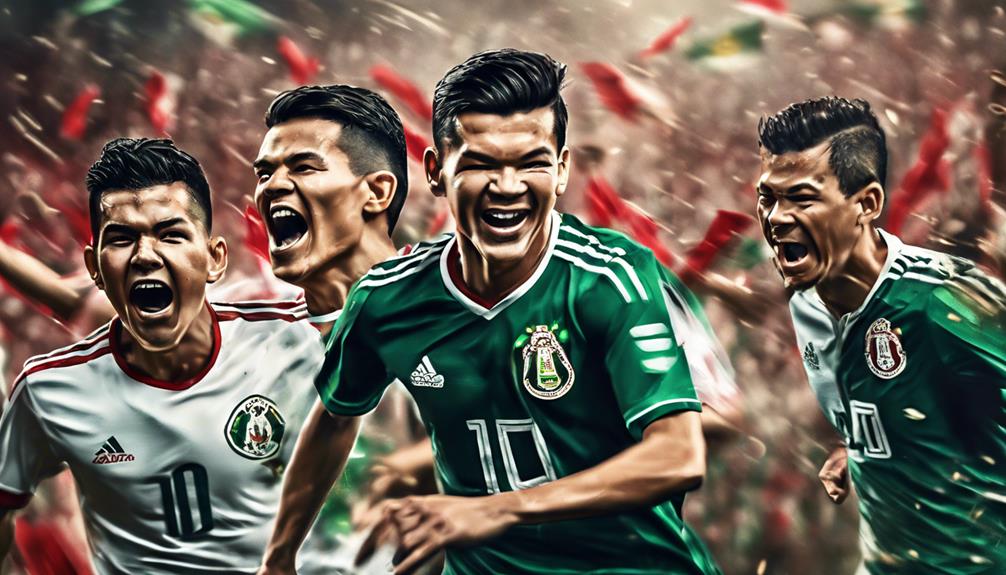
In the modern era of Mexico's national soccer team, their consistent FIFA World Cup qualifications have underscored their competitive spirit and talent.
- The team has excelled in World Cup qualifying, showcasing their ability to compete at the highest level of international football.
- Led by head coach Gerardo Martino, Mexico's national team has embraced a blend of experienced players and rising talents like Hector Herrera, Edson Alvarez, Raul Jimenez, Hirving Lozano, and Diego Lainez.
- Mexico has secured an impressive seven CONCACAF Gold Cup titles, demonstrating their dominance in regional competitions.
With players participating in leagues such as Major League Soccer, Eredivisie, La Liga, Serie A, and Primeira Liga, the national team's diverse experiences and skills contribute to their success on the international stage.
Under Martino's guidance, Mexico aims to continue their legacy of achievement in international football, fueled by the passion and talent of their players.
Notable Players and Managers
Exploring the Mexico National Soccer Team further reveals a roster of distinguished players and managers who've left a lasting impact on the sport both domestically and internationally.
Hugo Sánchez stands out as one of Mexico's greatest players, having scored an impressive 164 goals for Real Madrid.
Javier 'Chicharito' Hernández is another standout, having showcased his talents at clubs like Manchester United and Bayer Leverkusen.
Rafael Márquez holds a significant place in Mexican soccer history, captaining the national team in five World Cups, a feat shared only with Antonio Carbajal.
Cuauhtémoc Blanco, famous for his Cuauhtemiña move, made waves playing for the Chicago Fire in the MLS.
On the managerial front, Ricardo La Volpe shifted from player to coach and prominently led Mexico in the 2006 World Cup.
These individuals haven't only excelled on the field but have also contributed to shaping the soccer landscape in Mexico and beyond.
Conclusion
As you explore deeper into the rich history of the Mexico national soccer team, you'll uncover a tapestry of triumphs, challenges, and unforgettable moments.
Just like the team's iconic green jersey symbolizes growth and renewal, the players and managers have continued to push boundaries and make their mark on the international stage.
Keep exploring the world of El Tri and be inspired by the passion and dedication that defines this legendary team.


